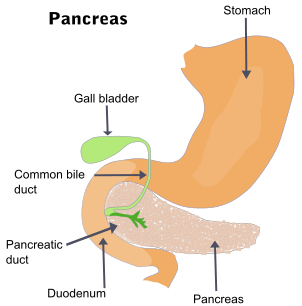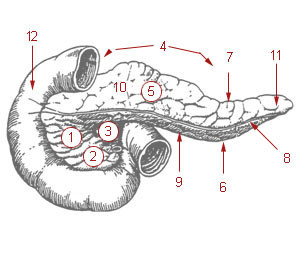What is Whipple surgery? Reasons for Whipple procedure
Whipple surgery is a major surgical procedure involving the gastrointestinal organs like the distal part of stomach (latter portion), part of pancreas and duodenum (first part of the small intestine). The medical term for Whipple surgery is pancreaticoduodenectomy. It is a standard procedure for certain cases of pancreatic cancer but due to the close proximity of the distal part of the stomach and duodenum, these structures may also be removed. Refer to pancreas location and the picture below for more information.
Whipple surgery was first performed successfully by a German surgeon named Dr Kausch. It was later perfected by the American surgeon Dr Allen Whipple in the first half of the 20th century, after whom the procedure is named.
Picture from Wikimedia Commons
The pancreas is an important organ of digestion (exocrine functions) and also controls blood glucose levels (endocrine functions). This is explained further under pancreas function. Food enters the stomach through the esophagus and is mechanically churned by the muscular stomach wall with the stomach secretions containing hydrochloric acid and other enzymes. The partially digested food known as chyme is then passed into the first part of the small intestine (duodenum) for further digestion and nutrient absorption. Here the pancreatic juices containing digestive enzymes, water and bicarbonate ions mixes with the intestinal chyme.
Picture from Wikimedia Commons
(1) head of pancreas, (2) uncinate process of pancreas,(3) pancreatic notch, (4) body of pancreas, (5) anterior surface of pancreas, (6) inferior surface of pancreas, (7) superior margin of pancreas, (8) anterior margin of pancreas, (9) inferior margin of pancreas, (10) omental tuber. (11) tail of pancreas, (12) duodenum
The head of the pancreas and the duodenum are supplied by the same blood vessel known as the gastroduodenal artery. The artery passes through the head of the pancreas and the removal of head of pancreas can compromise the blood supply to duodenum. Therefore the duodenum is also removed along with head of the pancreas in the Whipple procedure.
Why is Whipple surgery done?
Indications for Whipple Surgery
The Whipple procedure is a standard operation performed in operable cancers of the head, neck and the uncinate process of the pancreas. Close to 70% cancers of pancreas arise from these parts but only about 20% of pancreatic cancer patients are diagnosed at an operable stage. The Whipple procedure is also performed in cancers of the ampulla of Vater, distal common bile duct or duodenum which are near to the pancreas. It may also be performed in painful chronic pancreatitis.




